In their third campaign at the top tier of the Portuguese football league, FC Vizela earned 40 points in 34 games, a result which placed them in 11th place. The Vizelenses were promoted two years ago by a club legend Álvaro Pacheco who, after two consecutive promotions, brought them from the third tier to the first division of Portuguese football.
However, in a less successful start, Álvaro was fired and Manuel Tulipa, who was in charge of the U23 team, took his place in the Vizela seniors and completed the 2022/23 season. Yet, the Portuguese decided not to continue with this side next season, and Spanish manager Pablo Villar was appointed.
According to Transfermarkt, Vizela’s squad value in the 2022/23 season ranked in the 15th place compared with the other top-flight teams. Besides that, after checking Capology.com, it was also possible to conclude that Vizela had the worst payroll in the first league, and in that way, an 11th position in the first tier of Portuguese football is an excellent result.
Yet, this collective was capable of accomplishing a special feature: achieving the sixth-best defence in the league, with only 38 goals conceded.
In this tactical analysis, we’ll take a look at Vizela’s out-of-possession tactics and try to unveil what were the main reasons for their surprising defensive resilience.
Formation and statistical analysis
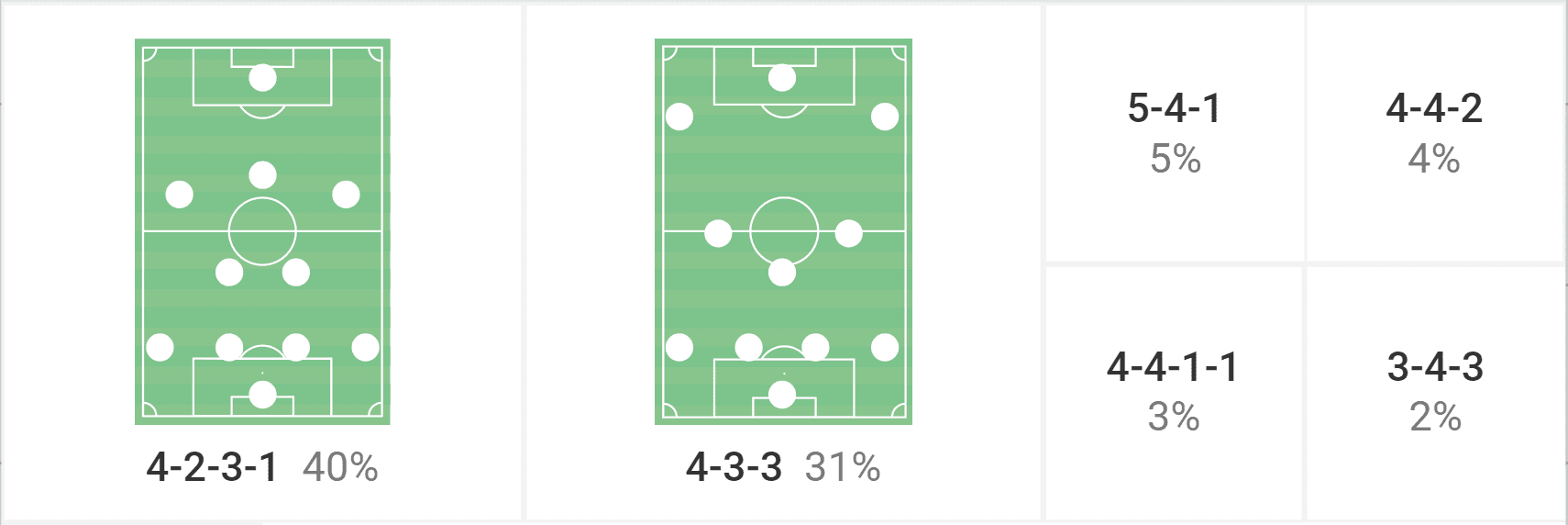
Vizela, in possession, aligns predominantly in a 4-2-3-1. However, during their build-up, there is mobility between the midfielders and often Raphael Guzzo and Samu explore more advanced spaces on the pitch, forming the classic 4-3-3. In addition, the wingers are usually positioned inside between the lines, providing the width on the flanks to the fullbacks who typically are involved in the offensive process.
Because their out-of-possession tactics are sometimes dependent on the opposition’s strategy, Vizela’s defensive formation had slight changes during the season. For instance, the majority of the league teams play in a two-centre-back system, leading Vizela to position in a 4-4-2, which can be turned into a 4-2-4 when the wingers uprise and press the fullbacks. Besides that, if the other team is organised and are playing in their half, the offensive midfielder can descend on the pitch forming a 4-2-3-1.
However, Tulipa made some adjustments in their team’s defensive approach whenever they played against a team which incorporates a three-centre-back system. For example, against Sporting, who plays in a 3-4-3, Vizela defended in a 5-4-1 as a main system.
Even though they like to press in a medium-high block, especially in the first few minutes where they are quite intense, due to some clear financial disparities, Vizela can make some adjustments in accordance with the side they are playing against.
Well-coordinated defensive line
After our analysis, we found out that one of the main reasons for Vizela’s defensive resistance is directly related to their backline behaviour without possession. In fact, the defenders, especially the centre-backs, seemed familiar with the covered and uncovered ball concepts which leads to upward and downward movements of the defensive block.
Let’s initially focus on the covered ball topic. We give this terminology to situations where the opponent has the ball in his possession but is turned to his own goal. With that said, it becomes more difficult for the opposition to seek depth and the defenders take advantage of that by upwarding their defensive line in the pitch.
Besides that, back-passes are also guides to an ascending defensive block and the Portuguese collective appeared to interpret it superbly. As a matter of fact, these back-passes are pressing indicators as well and whenever they are made, Vizela’s defenders not only rise their defensive block but also increase their pressing intensity.
Other pressing indicators like a bad pass or even an aerial ball in a more down zone on the opposition’s pitch are also a motive to increase their block and to boost their pressing. For instance, the sequence of images below reveals that a back pass is an indicator for Vizela to uprise their block on the pitch.


On the other hand, when the offender has the ball and his body shape is oriented to the front, we call it an uncovered ball situation due to the fact that the player has the possibility to make a long pass with depth in his horizon. In these cases, it is recommended that the defenders drop their positioning on the pitch, as we can see in the below image, in order to control the space on their backs.
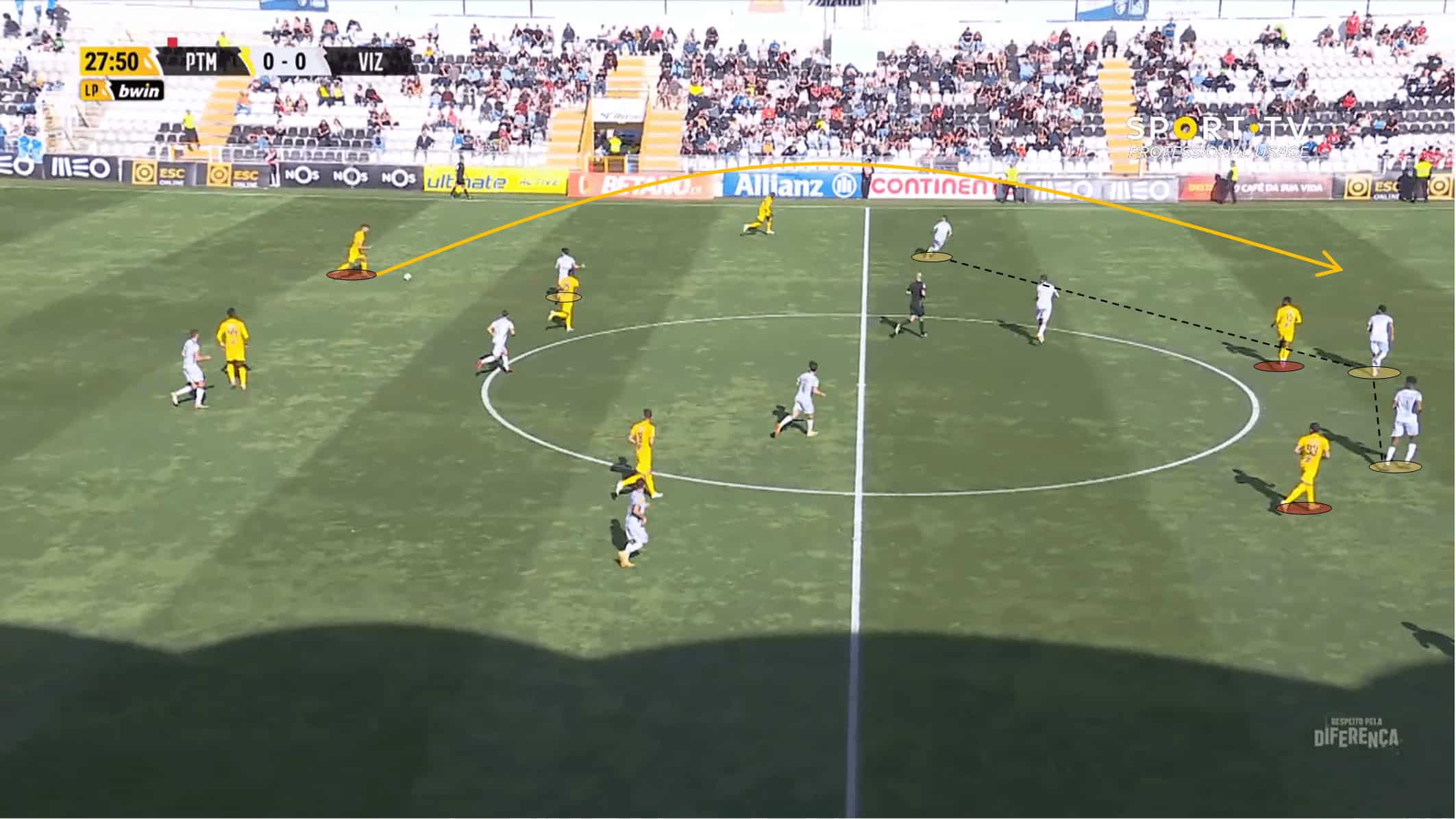
Midfielders’ important role in defensive cohesion
In times when interior playmaking is gaining more and more relevance, most teams think that the most effective way to defend is by conditioning their offenders to play in more exterior zones of the pitch. By protecting that space between the lines, the defensive team maintains the ball carrier further from the goal and consequently, the team is more assured defensively.
However, this defensive process is not as simple as it looks, due in great part to the number of players that position in those zones. So a great tactical understanding is required to interpret and “solve” every distinct situation during the game.
In Vizela’s case, the most regular midfielders were the experienced Claudemir, Raphael Guzzo slightly ahead and Samu as the offensive midfielder. As we mentioned earlier while the other team is in Vizela’s half, they organise defensively and Guzzo drops down right near Claudemir and Samu descends behind the striker.
The next image shows that both of the defensive midfielders have to be alert in their positioning and they constantly scan to understand if there is someone exploring the space right behind them.
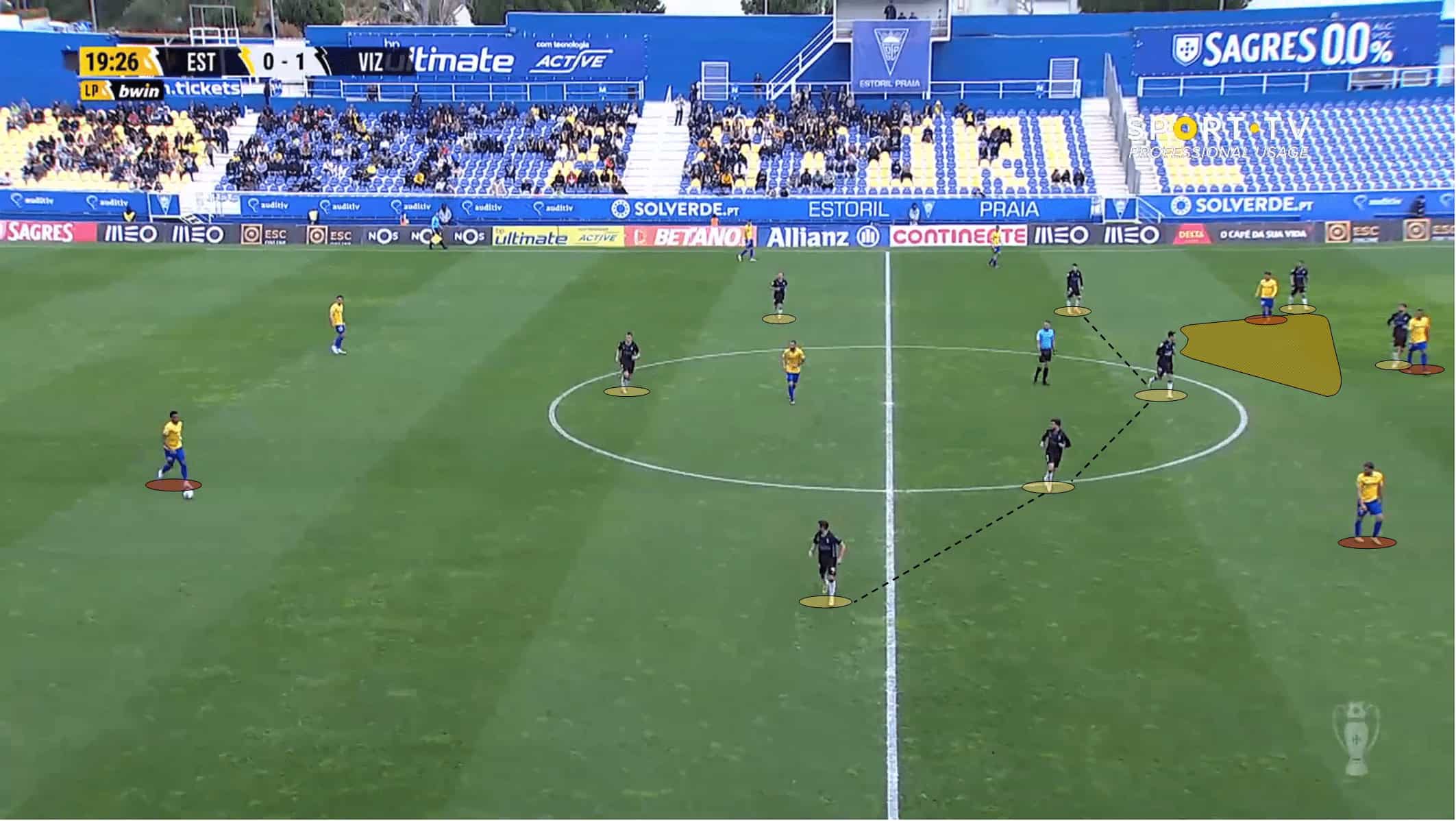
Another aspect concerning the midfielders’ defensive task that we found interesting was the constant and frequent covering whenever space was created after a movement. With this defensive adjustment, the midfielder increases the level of their team’s defensive cohesion and compactness.
The most common defensive cover made by the defensive midfielders happens when the fullback presses the opposition’s winger, creating a big space in behind. This situation is illustrated in the below image.
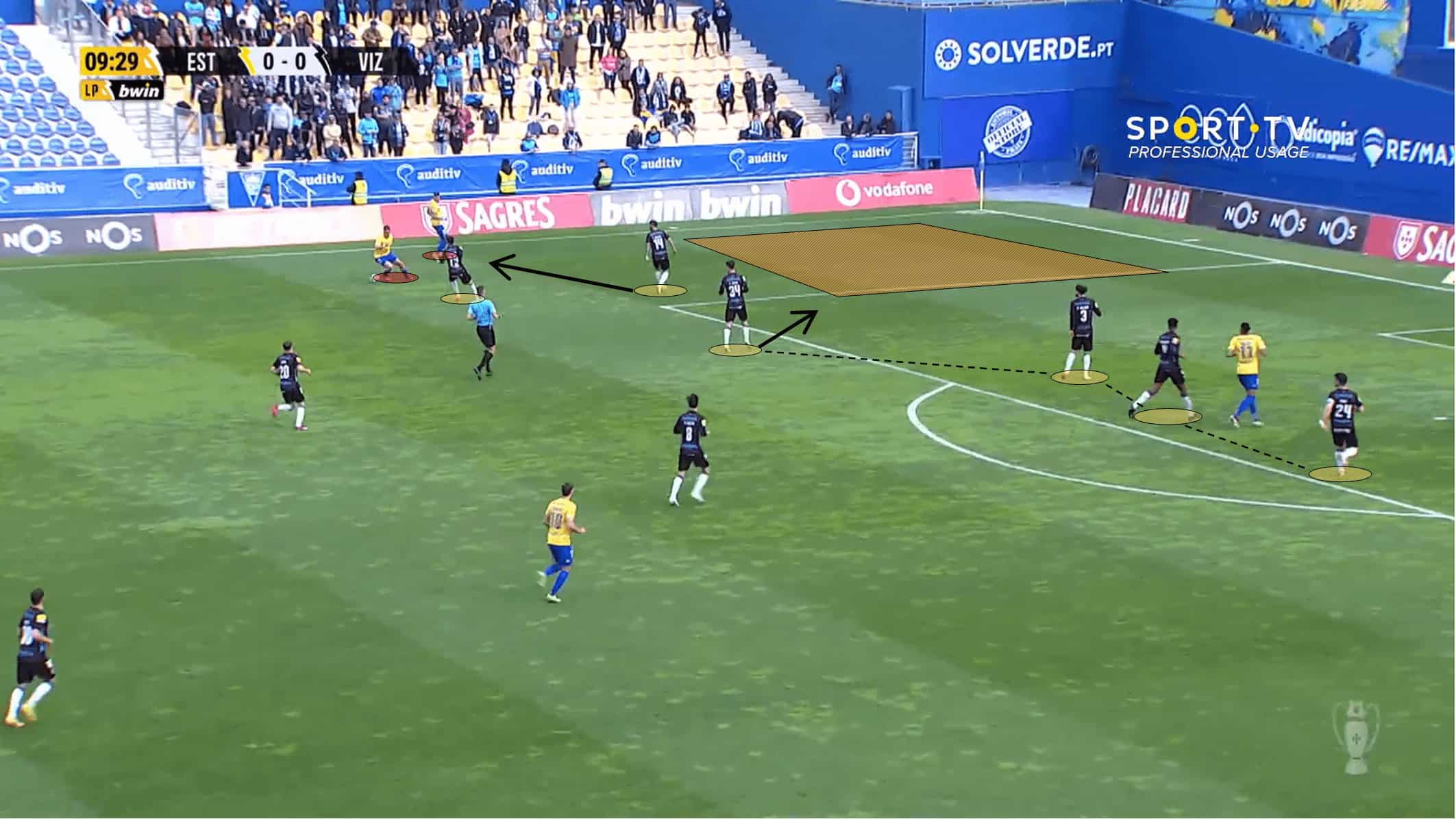
Yet, as we said, the number of players seeking the space between the lines can be significant, and in some cases, the defensive midfielders faced numerical inferiority. Though, Vizela seemed to operate as a whole and even the centre-backs intervened in this defensive task of conceding space between the lines.
In this particular case, like we can see below, while the centre-back leaves his normal post and presses the other team’s player in between the lines. The midfielder closes that gap by occupying his position.
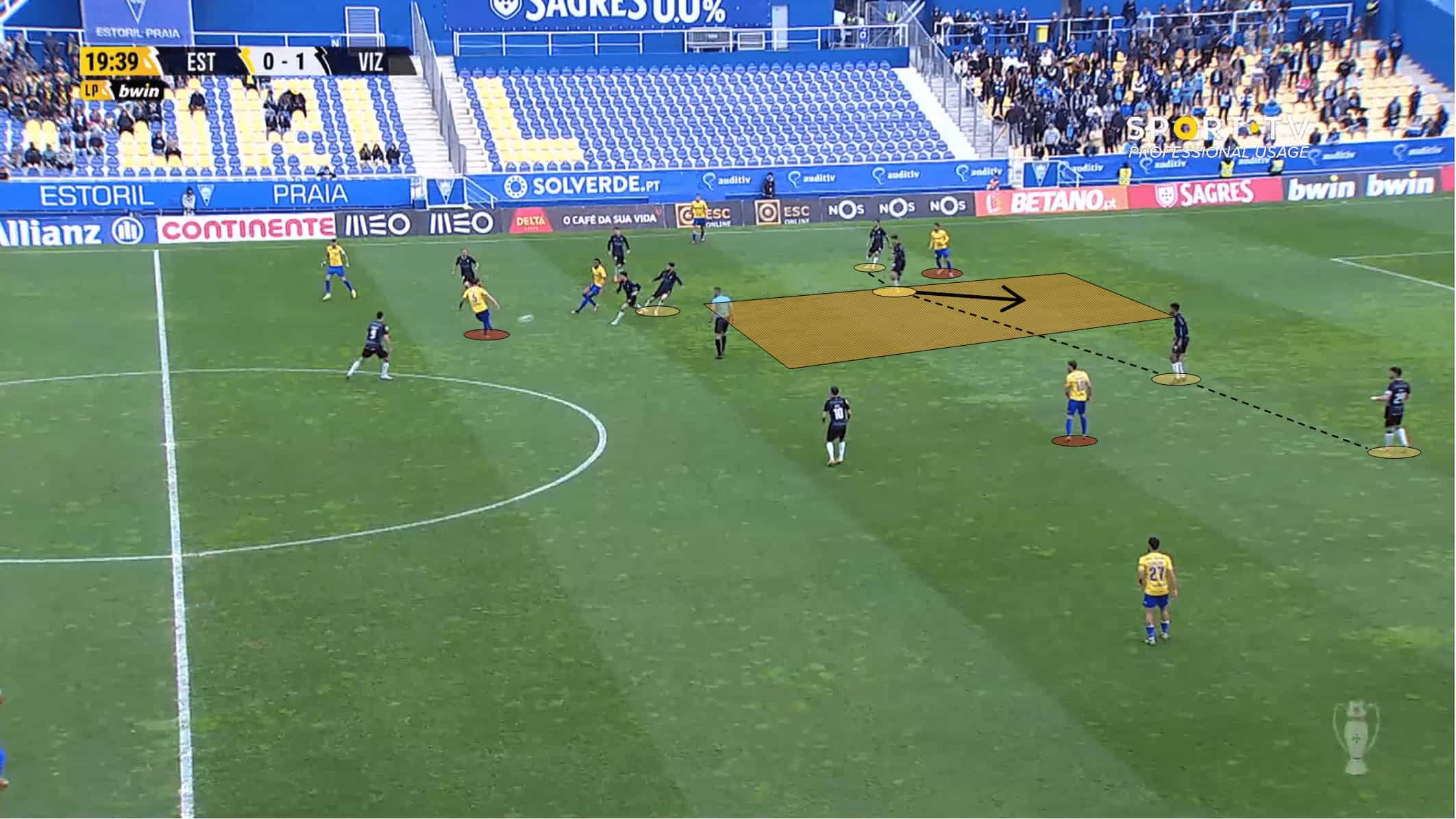
Additionally, another method to increase defensive efficiency is the addition of one more player in the back line, which in some specific situations can be very positive. Normally the tallest midfielder positions between the two centre-backs. However, there are some cases where the nearest player occupies that space forming a five-men line, similar to Simone Inzaghi‘s Inter.
These dynamics usually take place in uncovered ball situations where the attackers are near Vizela’s box, threatening their goal through a key pass to a teammate who is attacking the depth or even through crosses right near the end line.

Aggressiveness, determination and intelligence while defending
This Vizela team showed in the last few years to be competitive, rough and a difficult opponent to beat, even when playing against the top sides of the league. This determination is visible most of the time while defending where the Vizelenses were particularly aggressive in their reaction after the loss of possession.
As a matter of fact, Vizela’s players, mostly midfielders and attackers, press the ball carrier in great a number whenever they had lost it in order to obstruct and impede the other side’s action with the ball. In this particular case, Vizela is pressing the ball carrier with four players.

Even though this intensity and will to have the ball is an advantage in so far as they have bigger odds to restore their possession, it can have a downside if the team is both tactically and technically gifted. For example, if this overload of players in a small space takes place against a team which is good at playing in short spaces, like Roger Schmidt‘s Benfica, it can lead to an immediate counterattack, due to the space created during this exposure.
However, an aggressive team is not the same that a violent team. In fact, according to Wyscout, Vizela average approximately two successful tackles out of four, a stat which is above average in the league (approx. one out of three).
In addition, the 11th-placed Vizela also were also above average in terms of interceptions per game with an average of 46 surpassing their opponents with 42. As it goes, this is another evidence of a team that is clean and effective in re-establishing possession.
This team worked as a whole and demonstrated togetherness during the game when in some situations of numerical inferiority or equality in the flank, the winger tracked the offender’s fullback.
Finally, a small detail that we found relevant to show is in some way linked with centre-back maturity and tactical knowledge: the offside trap. In fact, although this isn’t the correct frame to evaluate as a whole a team’s defensive behaviour, we found it interesting because it embraces both the covered and uncovered ball concepts.
For instance, the defender while the ball is uncovered, dropped down on the pitch keeping an eye on the attacker. However, as soon as the ball carrier was marked, the centre-back quickly ascended and left the attacker offside.


Conclusion
As we discussed in this scout report, this Vizela side had more than just a satisfactory season, not only due to their financial conditions but also because of their defensive achievements. The coordination and mobility between the backline in covered and uncovered ball cases were essential to reach this defensive solidity.
Besides that, the midfielders also had an important role in protecting their goal from danger, whereby being determined to close the gap between the midfield and defensive lines they try to impede the offenders to create dangerous situations from inside. The midfield elements were also important in maintaining their defensive consistency by covering players who were out of position due to a lack of mobility.
With a new manager at the club, it will be interesting to see if he will maintain Vizela’s main strategy adopted, with some variations, by the two previous coaches or if Pablo Villar will innovate with some new tactical model. Additionally, it also begs the question: will the club owners invest, aiming to take Vizela to the next level in the upcoming season? Only time will tell.






Comments